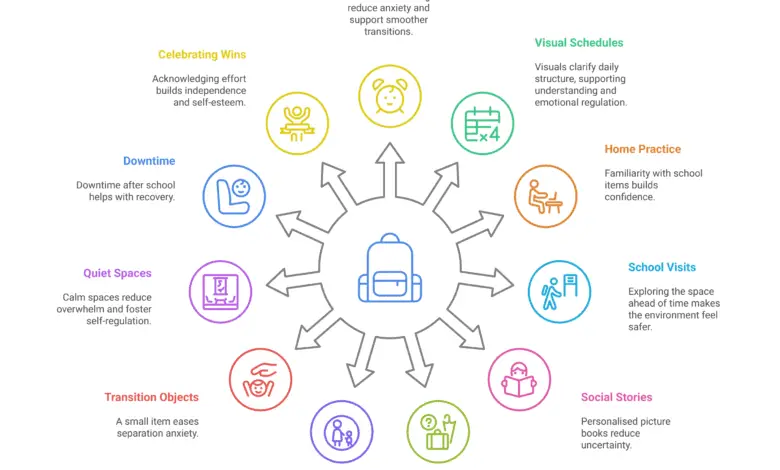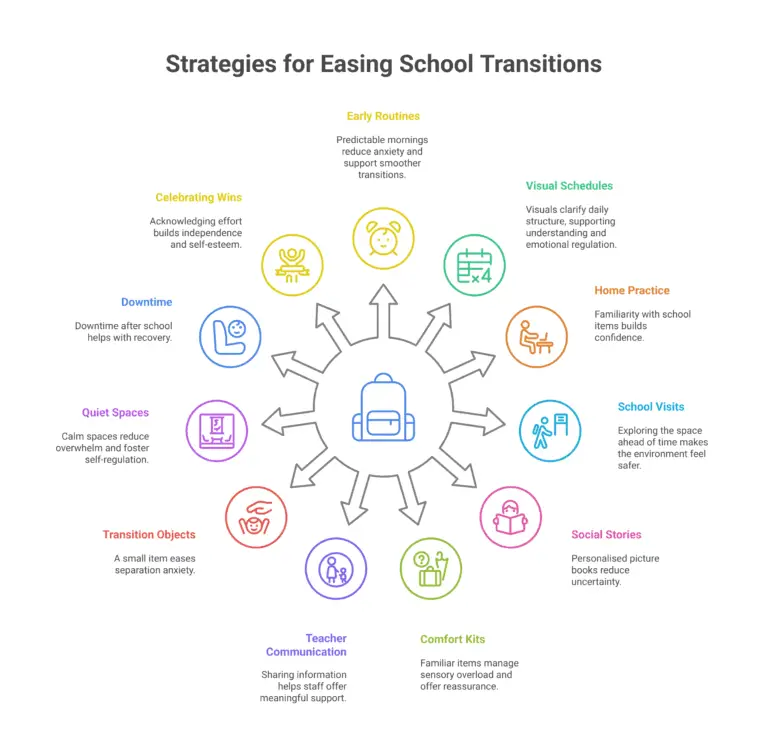
11 Back-to-School Tips for Autistic Children
11 Back-to-School Tips for Autistic Children
Back-to-school time can be an exciting yet challenging period for many families who have a child on the autism spectrum. Families can face many emotional, sensory, and practical obstacles during this period. Every autistic child is different, but most autistic children prefer environments which promote predictable structures, clear communication and soothing routines.
If families prepare for transitions or new starts, they can hopefully make the transition less of a challenge, reduce anxiety and promote a better response from the children and family as a whole.
Key Takeaways
| Tip | Why It Matters for Autistic Children |
|---|---|
| Start routines early | Predictable mornings reduce anxiety and support smoother transitions. |
| Use visual schedules | Visuals help clarify daily structure, supporting understanding and emotional regulation. |
| Practise school skills at home | Familiarity with uniforms, lunchboxes, and toileting builds confidence. |
| Visit the school in advance | Exploring the space ahead of time makes the new environment feel safer and more manageable. |
| Create a social story | Personalised picture books help children understand what to expect and reduce uncertainty. |
| Build a comfort kit | Familiar items can help manage sensory overload and offer reassurance. |
| Connect with teachers early | Sharing key information about your child helps staff offer meaningful support from day one. |
| Use a transition object | A small item from home can ease separation anxiety and offer emotional grounding. |
| Plan for quiet spaces and phased starts | Gradual returns and access to calm spaces reduce overwhelm and foster self-regulation. |
| Expect post-school fatigue | School can be draining; downtime after school helps with recovery. |
| Celebrate small wins | Acknowledging effort and progress builds independence and self-esteem. |
This guide provides practical strategies that acknowledge the diverse needs and wants of autistic children, and focus on both parent and child embracing the start of a new school year with ease, connection and confidence.
1. Start the Routine Early
Start to establish the school routine at least 1-2 weeks before school starts. For as long as you are waking, getting dressed and eating with the school day structure, you can really help the situation.
“During the holidays, I will do a countdown of nights back to school (visual) along with an activity plan of what they are doing during the holidays. I do this so that they get both exciting things to do, plus a reminder of school.” — Netmums parent
Re-establishing a routine that your child can familiarise themselves with is helpful in providing predictability and, therefore, a sense of control for autistic children. This can help reduce feelings of anxiety relating to the return to school. If you can keep the mornings stress-free and predictable, you can take away a lot of the haste, unpredictability, and anxiety from the day.
2. Use Visual Schedules
Many autistic children learn best with visual cues. The right visuals can help them understand the order of their day. You can create a daily schedule at home using icons or photos of your child getting up, the school bus, activities in school, lunch, break thime, and coming home.
“I’m wondering if a visual timetable may be helpful so she knows that she will be expected to move to a different class at some point in the day. Similarly, what about visual timers or advanced warnings of change? These transition tools can be helpful especially for autistic children who have a lot of anxiety as they are being given prior knowledge and time to prepare.” — Scope Forum user
Post the visual schedule in a conspicuous location where they can see it. Use and refer to the schedule so that your child can understand the transitions and recognise when things come to an end without being anxious.
3. Practice Important Skills At Home
When readying your child for school there are practical and emotional factors to prepare for. First, you will want to practice wearing their school uniform (and any other clothing they may need to wear), using a lunchbox, and closing a backpack. For children who are still learning independence, it is best to use clothes that are easy to remove and clear routines, so they can be successful.
If toileting is still a work in progress for your child, now is the time to practice going with them – and to look into autism potty training resources. These types of resources break down the toilet process into practical and structured steps expressly designed for autistic learners.
4. Go Visit the School
If possible, see if you can arrange a quiet visit to the school before school starts. Walking through the building, introducing them to teachers, locating bathrooms, and letting them check out safe and calming areas (like a cozy reading nook or quiet room) can help ease their anxiety about the new place. Take pictures during your visit – you may want them later for visual supports or social stories to reinforce this experience.
“What ultimately aided me was my father’s support in driving me to school. Additionally, I arranged for a couple of friends to meet me at the entrance. This strategy helped alleviate my fear of walking into the school alone and provided motivation, as I didn’t want them to feel like they were waiting for nothing.” — Reddit user
5. Create a Social Story
A social story is a personalised picture book to help your child understand what to expect in school. You can include pictures of important locations (classroom, cafeteria, play ground), familiar adults (teacher/aides), typical routines (waiting in lunch line, asking for help) and much more.
The overall goal is to provide a script for your child to use throughout the day, for reassurance. Social stories are a valuable way to develop a certain level of understanding and considerably reduce fears.
6. Create a Comfort Kit
Sensory overload is often experienced in educational settings. To help reduce this situation, make a comfort kit to keep in your child’s backpack.
“Sensory breaks throughout the day, and a safe space to go to (like a sensory room or quiet area). A transition space in the morning, for some…”
“Not hugely practical, but can help if you can get her in the building:
A transitional object – something from home that is small enough to fit in her pocket and touch for reassurance – a lucky stone / button etc.
I drew a small biro smiley face / heart / ‘hi!’ on my DDs palm so she could hold it / touch it / see it when she was stressed / missed me. I let her draw one on me when she was littler and she believed that when she touched hers I knew too. I’d say things like, ‘yes, when was it again? Was it when you were sitting down?… ‘ worked when she needed it.
I sprayed my perfume onto her wrist / sleeve – she could smell it for comfort. When stressed she still sometimes brings her teddy before bed at night for a spray – and she’s a mid-teen now.
Savlon! She associated the smell with care and comfort. When she went on a sleepover I put a tiny squeeze (like end of a cotton bud) into a little pot so she could put it on her own bruise / scab / anywhere!”
Depending on your situation, some items you could include are noise-cancelling headphones, chew necklaces, stress balls or a favorite sensory fidget. It is essential that everything in the comfort kit is labeled and that you inform the teacher about when and how to use these things.
7. Speak with the Teacher
Make sure you establish a clear line of communication right from the start of the year. A useful way to introduce your child to the school staff would be with a general ‘about me’ sheet.
It is useful to include the following elements: communication preferences, sensory sensitivities, strengths, and known triggers (if applicable). Teachers appreciate it when they have information that might help them support your child, from the very first day.
8. Use Transition Objects
A small item from home could be a helpful resource for your child to have in times of separation anxiety. This could be a picture of the family, a soft toy or a blanket.
Your child should have a ‘transition object’ in their pocket or backpack for comfort. During those first few weeks of transition, having something that can give a sense of security and emotional connection can be quite settling.
9. Consider Safe Spaces and Gradual Transition
“I think it sounds like she needs a safe time out space she can go to – with or without her work – during the day when she’s in the busier classroom, so she can decompress. If she is allowed to come and go as she needs, then it will become normalised and she will feel like she has an escape, so will maybe become less anxious.” — Scope Forum user
Work with your school to identify quiet areas where your child can retreat when feeling overwhelmed. Some children benefit from a gradual reintroduction to school hours, starting with shorter days and building up to full attendance.
10. Be Ready for a Tired Child
School takes a lot of energy – emotionally, mentally, and physically. Many autistic children spend the day ‘masking,’ or trying very hard to follow expected behaviours.
When they get home, they may express typical forms of stress release like meltdowns, shutdowns or withdrawing. Give them time and space to decompress: quiet play, gentle movement or even time away from the screen in a calming space.
11. Celebrate Success and Build Independence
Recognise effort, not only results. Maybe your child walked into the classroom with no prompts. Maybe they tried a different lunch food. Maybe they raised their hand in circle time. All of those are big victories. Celebrate the victories-small or big-they build and create confidence for the future.
All day long, kids have opportunities to make choices. What shirt do I want to wear? What snack do I want to eat? What book do I want to read? If you are providing opportunities for children with cognitive disabilities, narrow down the options, or they will become overwhelmed.
Instead of asking ‘What cup do you want to use?’ ask ‘Do you want to use the red cup or the blue cup?’ These choices are important. In time they will pay off towards independent living.
You’ll get there as a team!

Every child on the autism spectrum has a unique story, with individual strengths that can be relied upon despite the typical challenges of transition within a school year. You can create an opportunity for a successful year for your child by using the tips above. Each child’s transition requires support both physically and emotionally, but don’t forget to recognise those little steps of success too.
“It’s a tough time for all children but preparing in advance and with tips from other parents, your family as a team will get there!”